Introduction
This chapter “Human Eye and Colourful World” explores the fascinating aspects of vision and light. You will learn about the structure and functioning of the human eye, the process of seeing, and common eye defects. Additionally, this chapter explains phenomena like the dispersion of light, rainbow formation, and atmospheric refraction. Understanding these concepts enhances your knowledge of how we perceive the colorful world around us.
NCERT Solutions Human Eye and Colourful World
Human Eye
The human eye is one of the most valuable and sensitive sense organs. It enables us to see the wonderful world.
Structure of the Human Eye
The human eye is an optical instrument like a camera through which we see all the near and distant objects. It is round in shape whose diameter is approximately 2.3 cm. The human eye is a transparent substance made of protein.
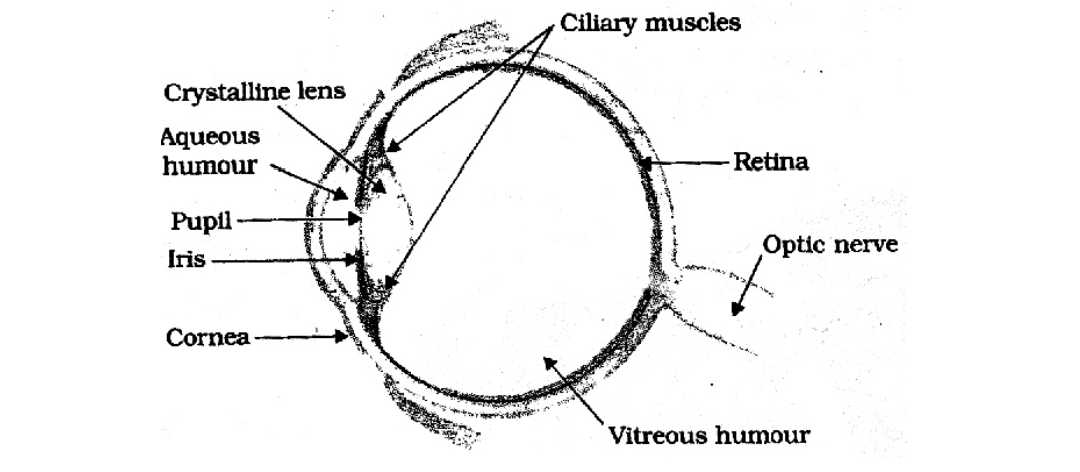
The human eye consists of the following parts
- Sclera: It is the outer covering, protective tough white layer called the sclera
- Eyeball- The eyeball is spherical in shape with a diameter of about 2.3 cm.
- Cornea : Light enters the eye through a thin membrane called the cornea. It forms a transparent bulge on front surface of the eyeball. Most of the refraction for the light rays entering the eye occurs at the outer surface of cornea.
- Ciliary muscles : The ciliary muscles are capable of modifying the curvature of the lens and thereby affecting the focal length of the lens.
- Iris : Iris is a dark muscular diaphragm that controls the size of the pupil.
- Pupil : Pupil is a small opening in the middle of the iris through which light enters the eye. The pupil regulates and controls the amount of light entering the eye.
- Eye Lens : Behind the pupil, there is a transparent and flexible jelly-like structure called eye lens. It is a convex lens. By the action of ciliary muscles, it changes its shape to focus light on the retina, it becomes thinner to focus distant objects and becomes thicker to focus nearby objects.
- Aqueous humour : It is a fluid which fills the space between cornea and the eye lens.
- Vitreous humour : The vitreous humour is a clear fluid which fills the eye between the lens and the retina. This fluid helps the eye hold its shape, with light being transmitted through it to the retina.
- Retina : Retina is a light-sensitive screen on which the image is formed. It is a delicate membrane having enormous number of light-sensitive cells. It converts the image formed by the Lens into electrical impulses. These electrical impulses are then transmitted to the brain through Optic nerves. It contains Rods and Cones.
- Optic nerve : These are the nerve which take the image to the brain in the form of electric signals.
Power Of Accommodation of Eye
The ability of the eye lens to adjust its focal length is called accommodation.
Focal Length of Eye-Lens
The distance from the eye lens to the retina is called the focal length of the eye lens.
Range of Vision of Human Eye
The distance from the near point to the far point is called the range of vision of human eye. For a normal eye, it is between 20 cm to infinity.
Far-Point
The maximum distance at which we can see an object clearly from the eye is called the far-point of the eye.
Note: For a normal defect-free eye, the far-point is at infinity.
Near-Point
The minimum distance at which we can see an object clearly from the eye is called the near-point of the eye.
Note: For a normal defect-free eye, the near-point is at 20 to 25 cm. It is called least distance of distinct vision.
Defects Of Vision and Their Correction
Sometimes, the eye may gradually lose its power of accommodation. In such conditions, the person can not see the object distinctly and comfortably. The vision becomes blurred due to refractive defects of the eye. When our eyes do not see any object clearly, a defect occurs in our eyes which is called defects of vision. This defect can be corrected by the use of suitable spherical lenses.
There are mainly three common defects of vision.
- Myopia or near-sightedness
- Hypermetropia or for-sightedness
- Presbyopia
Myopia ( near-sightedness )
When nearby objects are clearly visible but objects beyond a certain distance are not clearly visible, then this defect is called myopia.

Reason of Myopia
- Excessive curvature of eye lens (thick, decrease focal length)
- Elongation of the eye ball.
Correction
This defect can be corrected by using a concave lens of appropriate power.

Hypermetropia (far-sightedness)
When distant objects are clearly visible but near objects from a certain distance are not clearly visible, then this defect is called hypermetropia.
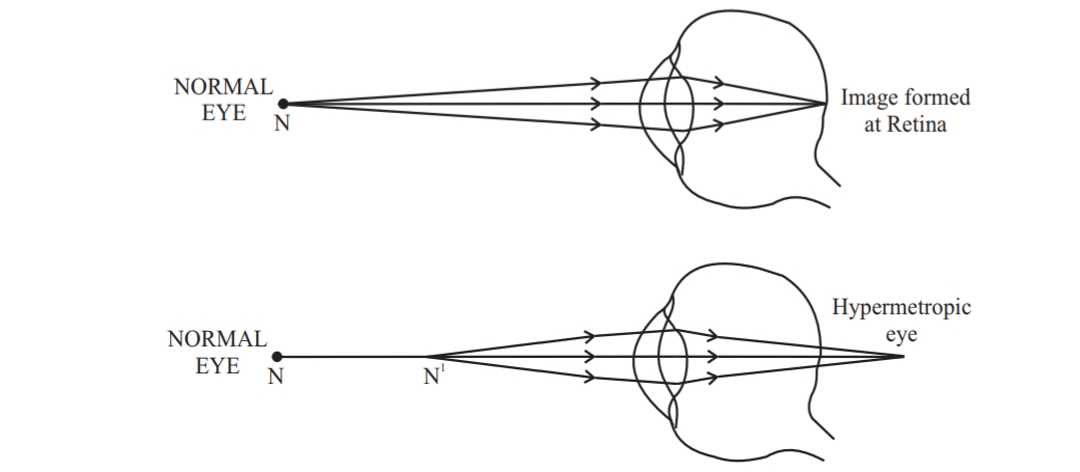
Reason of Hypermetropia
- Increase in focal length of the eye lens (Thin eye lens)
- Eye ball has become too small.
Correction
This defect can be corrected by using a convex lens of appropriate power.
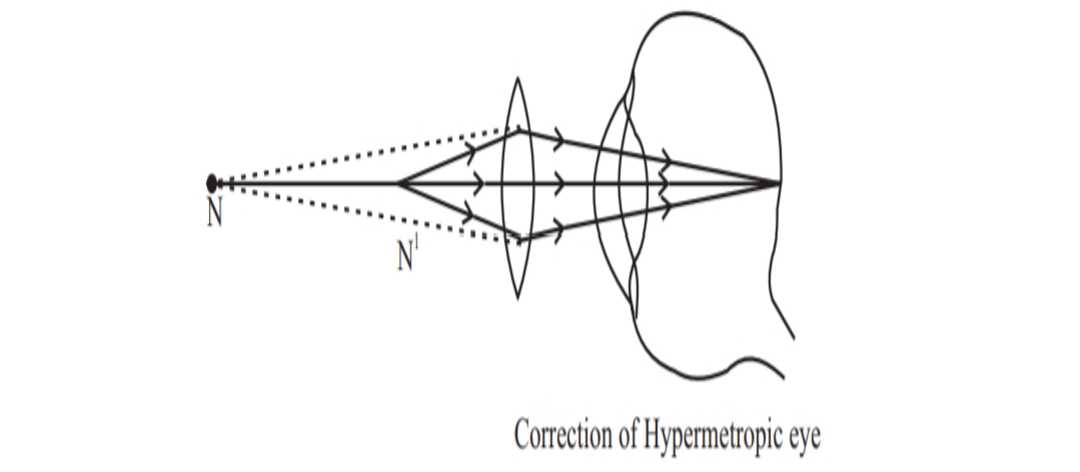
Presbyopia
When neither a near object nor a distant object is clearly visible, it is called Presbyopia.
Reason of Presbyopia
Gradual weakening of ciliary muscles and decreasing the flexibility of the eye lens.
Correction
This defect can be corrected by using of Bifocal Lens with appropriate power.
Colour Blindness
When a person is unable to recognize one or more colors, it is called color blindness.
- This defect occurs due to the lack of cone cells in the human eyes.
- This defect in human eyes is genetic. There is no treatment for it.
Question. Vishal can not see things clearly which are farther than 200 cm. Name the defect in his eyes. Prescribe a corrective lens with suitable power.
(Ans: Defect - Myopia , Power = - 0.5 D )
Question. Radha can not see when see holds book closer than 100 cm. Name the defect in her eyes. Prescribe a corrective lens with suitable power.( Normal eye near point = 25 cm)
Ans:
Prism
The transparent medium between two plane surfaces inclined at some angle is called a prism.
Refraction Of Light Through a Prism
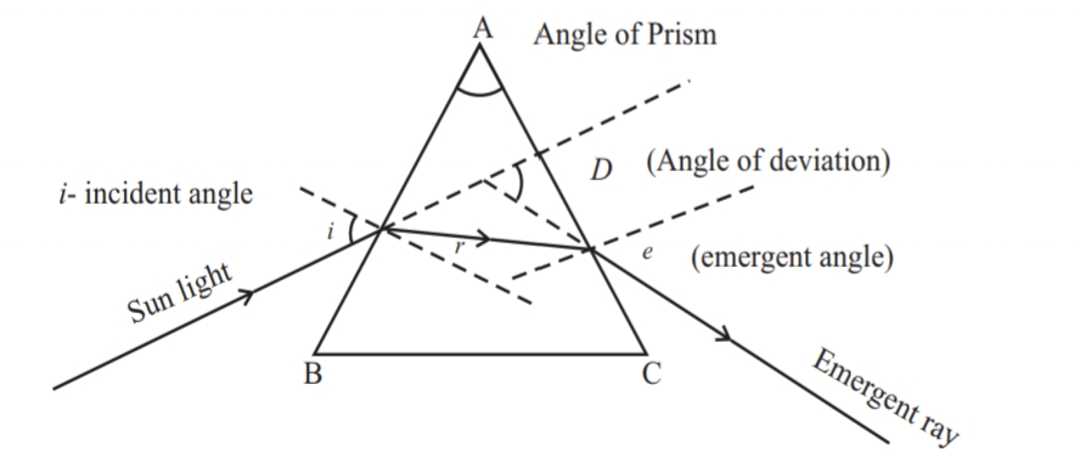
- In a prism, the angle between two surfaces is called a prism angle.
Dispersion of White Light By a Glass Prism
Dispersion of Light
The dispersion of light refers to the phenomenon where light is separated into its individual colors.
Dispersion of White Light by a Glass Prism
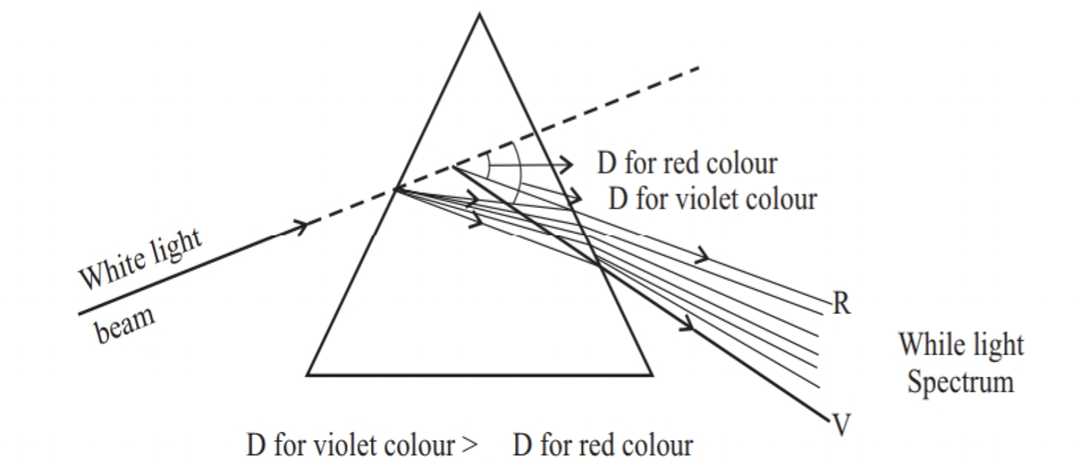
When white light is passed through a prism, it gets separated into its component colours, this phenomenon is called dispersion of light.
Explanation: When white light (which is a combination of all colors in the visible spectrum) passes through a prism, the different colors that make up the light are bent by different amounts due to their varying wavelengths. This causes the light to spread out into its component colors. The order of colors are violet, indigo, blue, green, yellow, orange and red commonly remembered by the acronym VIBGYOR.
- Spectrum: The band of the coloured components of a light beam is called its spectrum.
Atmospheric Refraction
1. Apparent Star Position– It is due to atmospheric refraction of star light.The temperature and density of different layer of atmosphere keeps varying. Hence we have different medium.
Distant star act as point source of light. When the starlight enter the earth’s atmosphere it undergoes refraction continuously, due to changing refractive index i.e. from Rarer to denser. It bends towards the normal.
Due to this the apparent position of the star is different from actual position.The star appear higher than its actual position.
2. Twinkling of Star– It is also due to atmospheric refractionDistant star act like a point source of light. As the beam of starlight keeps deviating from its path, the apparent position of star keeps on changing because physical condition of earth’s atmosphere is not stationary
Hence the amount of light enters our eyes fluctuate some time bright and some time faint. This is the “Twinkling effect of star”
3. Advance Sunrise and delayed sunset- This is also due to atmospheric refraction.Because of this sun is visible about 2 minutes earlier than actual sunrise and about 2 minutes after the actual sun set.
Scattering of Light
Tyndall Effect– When a beam of light strikes the minute particle of earth’s atmosphere suspended particles of dust and molecule of air the path of beam become visible. The phenomenon of scattering of light by the colloidal particle gives rise to Tyndall Effect.
It can be observed when sunlight passes through a canopy of a dense forest.The colour of the scattered light depends on the size of the scattering particles.
(1) Why cloud Appear white– The size of water droplet (scattering particle) is very large, hence scattered all wavelength of light almost equally.
(2) Why colour of sky is blue– The molecules of air and other fine particles in the atmosphere have size smaller than the wavelength of visible light. Since the blue has shorter wavelength than red, hence it will scattered the most.
- Class 10th Science Magnetic Effect of Electric Current
- Class 10th Science Electricity MCQ
- Class 12 Physics Practical File pdf Section A Experiment 6
- Class 12 Physics Practical File pdf Section A Experiment 2
- Class 12 Physics Practical File pdf Download Section A Experiment 1